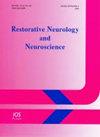Long-term outcomes of plasma exchange versus intravenous immunoglobulin for the treatment of Guillain-Barré Syndrome: A double-blind, randomized clinical trial
IF 1.6
4区 医学
Q4 NEUROSCIENCES
引用次数: 0
Abstract
Background: Most previous studies comparing the effectiveness of Plasma Exchange (PE) or intravenous immunoglobulin (IVIG) in treating Guillain-Barre syndrome (GBS) have focused on the short-term outcome at around 1 month. Objective: To compare the long-term efficacy of PE and IVIG at one year in adult patients with GBS. Methods: Eighty-one adult patients with acute GBS were randomized into two groups with a ratio of 2 : 1: PE (N = 54) and IVIG (N = 27). Patients were assessed with the Medical Research Council sum score (MRC sum score), GBS Disability Scale (GDS), and Functional assessment of acute inflammatory neuropathy (FAAIN) at baseline, ten days, one month, three months, and one year. Neurophysiological examinations were performed at baseline and three months following treatment. Results: There were no significant differences between groups in demographic, clinical, and laboratory data. Both treatments produced a significant improvement in all clinical rating scales in both groups that continued up to one year. There were significant differences in the time course of recovery in the MRC and FAAIN scales, with significantly more improvement in the IVIG group at 1 and 3 months, although there was no significant difference in outcome at one year. However the effect size showed measurable differences between the PE and IVIG groups across the different measures at one-year. Electrophysiological studies showed equal improvement in most measures in both groups at three months, with a slightly greater effect in the IVIG group. Conclusion: long term outcomes of IVIG and PE were equivalent. However the effect size showed measurable differences between the PE and IVIG groups across the different measures at one-year follow-up that indicate the superiorty of IVIG. There was also a tendency for improvement to be slightly faster in the IVIG group.血浆置换与静脉注射免疫球蛋白治疗格林-巴利综合征的长期疗效对比:双盲随机临床试验
背景:以往大多数比较血浆置换(PE)或静脉注射免疫球蛋白(IVIG)治疗格林-巴利综合征(GBS)疗效的研究都侧重于一个月左右的短期疗效。目的:比较PE和IVIG对成年GBS患者一年的长期疗效。方法:将 81 名急性 GBS 成年患者随机分为两组,两组的比例为 2 :1:PE(54 人)和 IVIG(27 人)。在基线、十天、一个月、三个月和一年时,对患者进行医学研究委员会总分(MRC sum score)、GBS 残疾量表(GDS)和急性炎症性神经病变功能评估(FAAIN)。在基线和治疗后三个月进行了神经电生理检查。结果:治疗组之间在人口统计学、临床和实验室数据方面没有明显差异。两种治疗方法都能明显改善两组患者的所有临床评分量表,并持续一年。MRC和FAAIN量表的恢复时间有明显差异,IVIG组在1个月和3个月时的改善程度明显更大,但一年后的结果没有明显差异。不过,在一年后的不同指标上,PE 组和 IVIG 组的效应大小显示出明显的差异。电生理学研究显示,在三个月时,两组在大多数指标上都有相同的改善,而 IVIG 组的效果稍好。结论:IVIG 和 PE 的长期疗效相当。但在一年的随访中,PE 组和 IVIG 组在不同指标上的效应大小显示出明显的差异,这表明 IVIG 更胜一筹。此外,IVIG 组的病情改善速度略快。
本文章由计算机程序翻译,如有差异,请以英文原文为准。
求助全文
约1分钟内获得全文
求助全文
来源期刊
CiteScore
5.40
自引率
3.60%
发文量
22
审稿时长
>12 weeks
期刊介绍:
This interdisciplinary journal publishes papers relating to the plasticity and response of the nervous system to accidental or experimental injuries and their interventions, transplantation, neurodegenerative disorders and experimental strategies to improve regeneration or functional recovery and rehabilitation. Experimental and clinical research papers adopting fresh conceptual approaches are encouraged. The overriding criteria for publication are novelty, significant experimental or clinical relevance and interest to a multidisciplinary audience. Experiments on un-anesthetized animals should conform with the standards for the use of laboratory animals as established by the Institute of Laboratory Animal Resources, US National Academy of Sciences. Experiments in which paralytic agents are used must be justified. Patient identity should be concealed. All manuscripts are sent out for blind peer review to editorial board members or outside reviewers. Restorative Neurology and Neuroscience is a member of Neuroscience Peer Review Consortium.

 求助内容:
求助内容: 应助结果提醒方式:
应助结果提醒方式:


